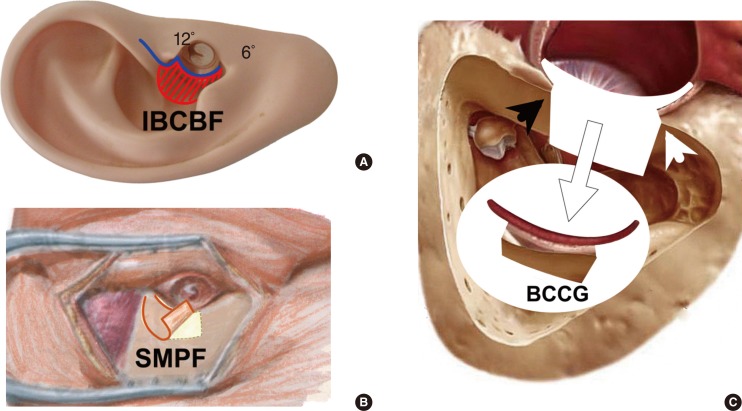Clin Exp Otorhinolaryngol.
2015 Sep;8(3):230-236. 10.3342/ceo.2015.8.3.230.
Obliteration of Radical Cavities and Total Reconstruction Procedure Without Staging After Canal Wall Down Mastoidectomy: Long-term Results
- Affiliations
-
- 1Department of Otolaryngology-Head and Neck Surgery, Tri-Service General Hospital, National Defense Medical Center, Taipei, Taiwan. borrong_huang@hotmail.com
- KMID: 2117517
- DOI: http://doi.org/10.3342/ceo.2015.8.3.230
Abstract
OBJECTIVES
We evaluate the long-term surgical and hearing results using a canal wall down mastoidectomy technique followed by cavities obliteration, canal wall reconstruction and ossiculoplasty without staging.
METHODS
A total of 44 patients between January 2002 and October 2009 were selected and 27 of them were revision cases. Preoperative and postoperative pure tone average (PTA) and air-bone gap (ABG) were assessed and compared 1 and 4 years after surgery.
RESULTS
The middle ear was well healed and aerated in 40 patients (90.9%) and the tympanic membrane was intact in 42 patients (95.5%). Recurrent cholesteatoma was found on postoperative follow-up in two of the revision patients (7.4%) but none in the primary patients. Seven patients were found to have partial canal bone absorption, but revision surgery was not required. Over 86.4% of all cases were water resistant. Long-lasting improvement and/or preservation of hearing, with maintenance of PTA-ABG closure in 63.7% of all cases within 20 dB, were obtained.
CONCLUSION
The efficacy of our technique after a canal wall down mastoidectomy is satisfactory, and the rate of complication is acceptably low. We believe that our technique could be a convenient method in disease control and providing an excellent basis for hearing restoration simultaneously.
Keyword
MeSH Terms
Figure
Reference
-
1. Singh V, Atlas M. Obliteration of the persistently discharging mastoid cavity using the middle temporal artery flap. Otolaryngol Head Neck Surg. 2007; 9. 137(3):433–438. PMID: 17765771.
Article2. Gantz BJ, Wilkinson EP, Hansen MR. Canal wall reconstruction tympanomastoidectomy with mastoid obliteration. Laryngoscope. 2005; 10. 115(10):1734–1740. PMID: 16222186.
Article3. Gyo K, Sasaki Y, Hinohira Y, Yanagihara N. Residue of middle ear cholesteatoma after intact canal wall tympanoplasty: surgical findings at one year. Ann Otol Rhinol Laryngol. 1996; 8. 105(8):615–619. PMID: 8712631.
Article4. Wilson KF, Hoggan RN, Shelton C. Tympanoplasty with intact canal wall mastoidectomy for cholesteatoma: long-term surgical outcomes. Otolaryngol Head Neck Surg. 2013; 8. 149(2):292–295. PMID: 23674568.5. Wolfensberger M, Hilger PA, Hilger JA. Conchal bowl and postauricular flaps for reconstruction of the external auditory canal. Otolaryngol Head Neck Surg. 1983; 8. 91(4):404–406. PMID: 6415588.
Article6. Kim MB, Choi J, Lee JK, Park JY, Chu H, Cho YS, et al. Hearing outcomes according to the types of mastoidectomy: a comparison between canal wall up and canal wall down mastoidectomy. Clin Exp Otorhinolaryngol. 2010; 12. 3(4):203–206. PMID: 21217961.
Article7. Edfeldt L, StrOmbAck K, Kinnefors A, Rask-Andersen H. Surgical treatment of adult cholesteatoma: long-term follow-up using total reconstruction procedure without staging. Acta Otolaryngol. 2013; 1. 133(1):28–34. PMID: 23113656.
Article8. Roberson JB Jr, Mason TP, Stidham KR. Mastoid obliteration: autogenous cranial bone pAte reconstruction. Otol Neurotol. 2003; 3. 24(2):132–140. PMID: 12621322.9. McElveen JT Jr, Chung AT. Reversible canal wall down mastoidectomy for acquired cholesteatomas: preliminary results. Laryngoscope. 2003; 6. 113(6):1027–1033. PMID: 12782816.
Article10. Leatherman BD, Dornhoffer JL. The use of demineralized bone matrix for mastoid cavity obliteration. Otol Neurotol. 2004; 1. 25(1):22–25. PMID: 14724487.
Article11. Mahendran S, Yung MW. Mastoid obliteration with hydroxyapatite cement: the Ipswich experience. Otol Neurotol. 2004; 1. 25(1):19–21. PMID: 14724486.
Article12. Ramsey MJ, Merchant SN, McKenna MJ. Postauricular periosteal-pericranial flap for mastoid obliteration and canal wall down tympanomastoidectomy. Otol Neurotol. 2004; 11. 25(6):873–878. PMID: 15547414.
Article13. Takahashi H, Iwanaga T, Kaieda S, Fukuda T, Kumagami H, Takasaki K, et al. Mastoid obliteration combined with soft-wall reconstruction of posterior ear canal. Eur Arch Otorhinolaryngol. 2007; 8. 264(8):867–871. PMID: 17340129.
Article14. Linthicum FH Jr. The fate of mastoid obliteration tissue: a histopathological study. Laryngoscope. 2002; 10. 112(10):1777–1781. PMID: 12368614.
Article15. Black B. Mastoidectomy elimination: obliterate, reconstruct, or ablate? Am J Otol. 1998; 9. 19(5):551–557. PMID: 9752959.16. Grote JJ, van Blitterswijk CA. Reconstruction of the posterior auditory canal wall with a hydroxyapatite prosthesis. Ann Otol Rhinol Laryngol Suppl. 1986; Mar-Apr. 123:6–9. PMID: 3083756.
Article17. Clark MP, Bottrill I. SerenoCem-glass ionomeric granules: a 3-year follow-up assessment of their effectiveness in mastoid obliteration. Clin Otolaryngol. 2007; 8. 32(4):287–290. PMID: 17651273.18. Brown JS. A ten year statistical follow-up of 1142 consecutive cases of cholesteatoma: the closed vs. the open technique. Laryngoscope. 1982; 4. 92(4):390–396. PMID: 7070181.
- Full Text Links
- Actions
-
Cited
- CITED
-
- Close
- Share
- Similar articles
-
- Modified Canal Wall Down Mastoidectomy Without Meatoplasty
- Reconstruction of the Posterior Canal Wall with Mastoid Obliteration after Canal Wall Down Mastoidectomy
- Mastoid Obliteration with Bone Paste and Fat
- A Case of Repair of Retroauricular Skin Defect and Mastoid Cavity with Posterior Wall Reconstruction Using Tutoplast(R)(Allograft Cancellous Bone Chip) and Bone Dust after Canal Wall Down Mastoidectomy
- Mastoid Obliteration with Silicone Blocks after Canal Wall Down Mastoidectomy



